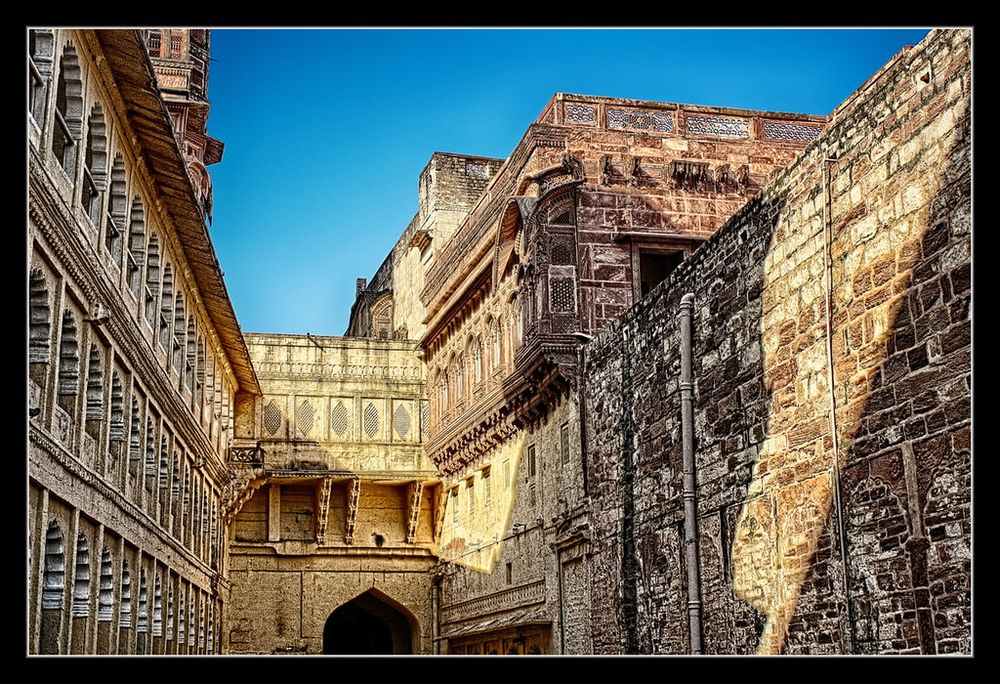Mehrangarh Fort: Where History Lives in Brick, Mortar, and the Shadows of Death

Majestically perched atop a hill in the enchanting city of Jodhpur, Rajasthan, stands the formidable Mehrangarh Fort. This magnificent structure, steeped in history, offers a captivating journey into the past, where brick and mortar intertwine with tales of valor, conquests, and the inevitability of death. As one explores the fort's imposing walls, intricate architecture, and echoing corridors, it becomes evident that Mehrangarh is not merely a monument but a living testament to the triumphs and tragedies of a bygone era.
A Fortress of Legends:
Mehrangarh Fort, built in the 15th century by Rao Jodha, the founder of Jodhpur, stands as a symbol of the city's indomitable spirit. Constructed primarily with red sandstone, the fort stretches across 5 kilometers with its massive walls rising 120 feet high. Its strategic location atop a 410-foot hill offered unparalleled protection, making it virtually impregnable.
The Architecture that Stands Tall:
The architectural grandeur of Mehrangarh Fort is nothing short of awe-inspiring. From intricately carved jharokhas (balconies) to majestic palaces and courtyards, every corner reveals a story waiting to be discovered. The fort's palaces, such as Moti Mahal (Pearl Palace), Phool Mahal (Flower Palace), and Sheesh Mahal (Mirror Palace), showcase the opulent lifestyle of the Rajput rulers.
The imposing gateways, such as Jai Pol, Fatteh Pol, and Loha Pol, serve as reminders of the fort's historical significance. Each entrance bears the marks of battles fought and won, and some even display the handprints of the queens who committed sati (self-immolation) as a testament to their loyalty.
Death and Sacrifice:
While the Mehrangarh Fort exudes grandeur and splendor, it also holds within its walls stories of sacrifice and death. The chattris (cenotaphs) inside the fort complex pay homage to the brave Rajput warriors who laid down their lives defending their honor and kingdom. These marble memorials stand tall, honoring the bravery and valor of those who fought till their last breath.
The fort's museum houses an extensive collection of weapons, armor, and artifacts, serving as a reminder of the bloodshed and sacrifices made within these walls. The galleries vividly depict the battles fought and the lives lost, preserving the memory of those who shaped the region's history.
Preserving the Legacy:
Mehrangarh Fort has withstood the test of time, witnessing the rise and fall of empires, yet standing firm in its place. The Mehrangarh Museum Trust, established in 1972, has diligently worked to conserve and showcase the fort's rich heritage. The trust's efforts in restoration, preservation, and educational programs have earned Mehrangarh Fort its reputation as one of India's best-maintained historical sites.
Mehrangarh Fort stands as a magnificent tribute to the past, reminding visitors of the valor, sacrifice, and the inevitability of death that is intricately woven into its very foundations. It serves as a testament to the rich cultural heritage of Rajasthan and the indomitable spirit of its people. As one traverses the ancient walls and explores its architectural marvels, Mehrangarh Fort offers a glimpse into a bygone era, where brick, mortar, and the echoes of history coexist in harmony.
Photo: Michael Foley/Flickr
Mehrangarh Fort: Where History Lives in Brick, Mortar, and the Shadows of Death
Photo: Manfred Sommer/Flickr
Mehrangarh Fort: Where History Lives in Brick, Mortar, and the Shadows of Death
Photo: Daniel Mennerich/Flickr
Mehrangarh Fort: Where History Lives in Brick, Mortar, and the Shadows of Death
Photo: Daniel Mennerich/Flickr

No comments:
Post a Comment
Note: only a member of this blog may post a comment.